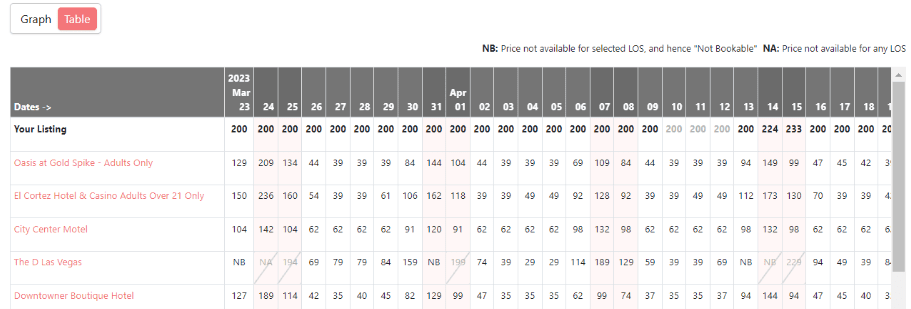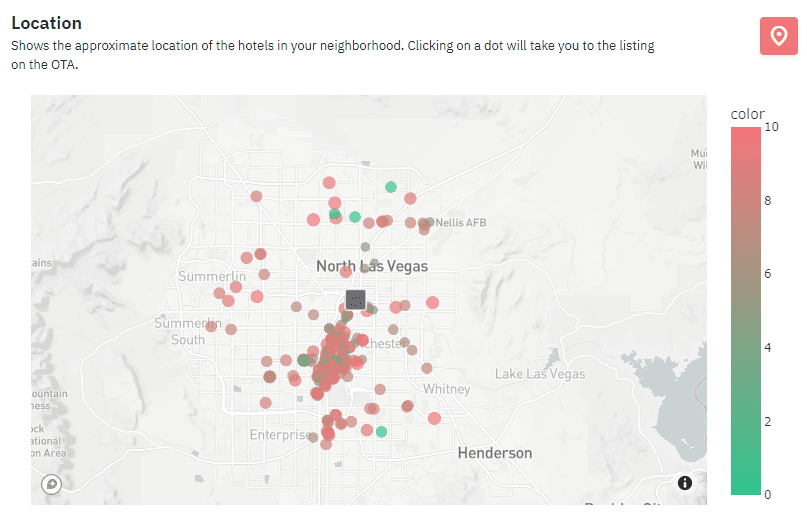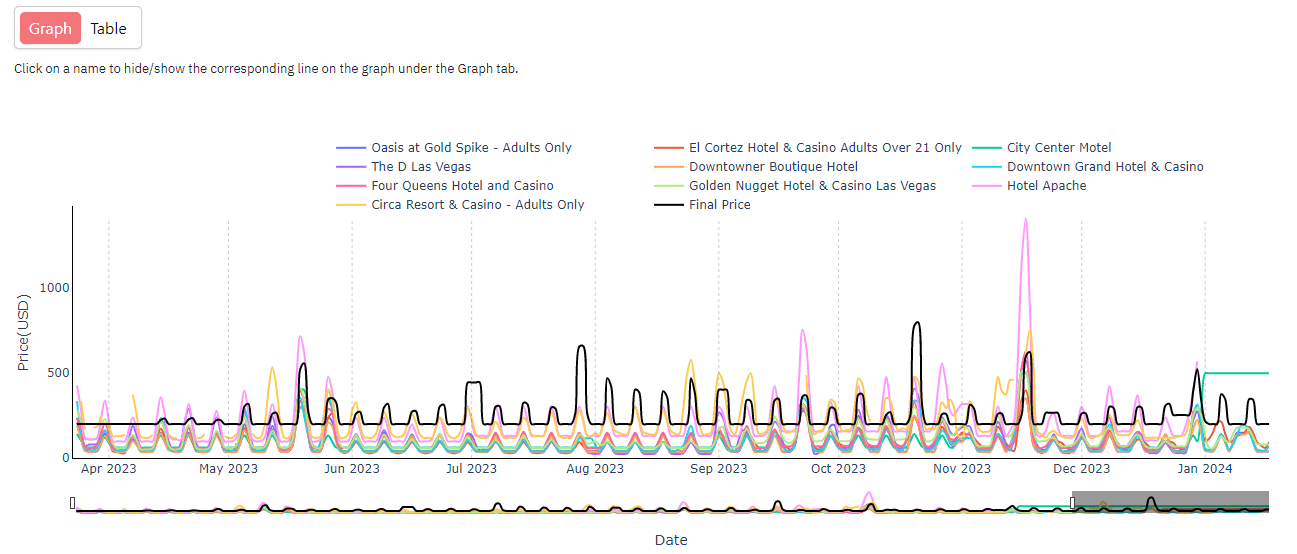This month, we’re introducing the Hotel Data tab, a new section displaying an improved product feature called the Hotel Price Tracker. It is an excellent occasion for us to step back and discuss why you should care about benchmarking your peers, the local market, and even hotels (even if you are a short-term rental manager). So, we’ll talk about benchmarking, creating sets of comparable properties, tracking short-term rental properties with our Neighborhood Data, and tracking other property types in your local market, such as hotels, in the Hotel Data tab.
Bonus: We’ve also added new charts to our Pacing Reports. You will find details at the end of the article.
What’s happening: A third tab is now available on the Review Prices view.
Our PriceLabs team is happy to announce that you have a new section to help you make informed pricing decisions and stay competitive in the market: the Hotel Data tab. This new feature is available on the listing page alongside the Calendar and Neighborhood Data tabs.
To access these tabs, navigate to the Pricing Dashboard and select a specific listing. Then, click the “Review Prices” button to access the Calendar, Neighborhood Data, and Hotel Data tabs.

Calendar Tab: Unchanged.
The Calendar tab remains unchanged and displays a monthly calendar with the recommended prices for each night.
Neighborhood Data Tab: Focus on Short-Term Rentals.
The Neighborhood Data tab still displays data from short-term rentals in the immediate area of your listing. However, we have moved the data about local hotels to the new Hotel Data tab.
Hotel Data Tab: An Improved Hotel Price Tracker.
The new Hotel Data tab presents a new location for the Hotel Price Tracker and offers significant improvements. These include showing hotel prices based on different lengths of stay and the ability to view hotels on a map with star ratings.
With this powerful new analysis and tracking section, you can access even more valuable data to make informed pricing decisions and stay competitive. You will find further details about the Hotel Data tab in the remainder of this section.
Why effective benchmarking techniques are crucial for optimizing your pricing strategy.
In the dynamic and competitive world of short-term rentals, owners and managers like you must understand and leverage benchmarking principles to make informed decisions and stay ahead. This guide will discuss the importance of benchmarking, creating competitive sets for short-term rentals, and why looking at hotel data can provide valuable insights for pricing and length of stay strategies. By implementing these principles, you can optimize your property’s performance, revenues, and overall success in the market.
1.1. Key Principles of Benchmarking for Strategic Pricing
Benchmarking is a critical process that enables you to evaluate your property’s performance by comparing it with other properties in your local and hyper-local market. Understanding how well your property is doing in relation to competitors is essential for several reasons:
- Identifying Strengths and Weaknesses: Benchmarking helps you determine areas where your property excels or underperforms compared to others. By recognizing these strengths and weaknesses, you can make targeted improvements to your property and its offerings.
- Staying Competitive: Keeping track of competitor performance allows you to stay updated on market trends and ensures that you maintain a competitive edge. Adjusting your strategies based on this information can help you attract more guests and improve your property’s overall performance.
- Learning from Best Practices: By analyzing your competitors’ strategies and successes, you can identify best practices and innovative ideas to incorporate into your property’s management and marketing efforts.
- Setting Realistic Goals and Expectations: Benchmarking provides a realistic perspective on your property’s performance, which can help you set achievable goals and expectations for future growth and improvement.
- Optimizing Pricing Strategy: Comparing your property’s pricing with competitors can help you identify whether you charge too much or too little. Adjusting your pricing strategy based on this information can increase bookings and revenue.
To effectively benchmark, you need to create a comp set or a group of properties similar to yours in terms of location, size, amenities, and target market.
1.2. Creating Competitive Sets in the Context of Short-Term Rentals
“Comp sets” is short for “competitive sets.” These are groups of properties similar to you can compare your property’s performance. Creating comp sets involves selecting specific criteria to filter properties, generating a list of potential competitors, and then including or excluding properties to form a well-defined group.
You can create Comp sets for short-term rentals using various tools and platforms that offer filtering options based on location, property type, size, amenities, and other relevant factors. It helps you discover local competitors that closely match your property’s characteristics.
Creating comp sets has several advantages:
- Discovering Local Competitors: Comp sets help you identify other properties in your area that are similar to yours and target the same market. Thus, you can understand your competitive landscape and make better-informed decisions about your property’s positioning and strategies.
- Tracking Performance: Once you have created a comp set, you can track the performance of these properties over time. It enables you to monitor how well your property is doing compared to others in the group and identify trends or changes that may impact your business.
- Customization: Creating comp sets allows you to include only properties that are truly comparable to your own. It ensures that the performance data you track is relevant and meaningful. For instance, you could compare your property to others with a similar target market or positioning, which can provide valuable insights into your niche.
- Benchmarking: Comp sets enable you to measure your property’s performance against that of similar properties. It can help you identify areas where your property is underperforming and make targeted improvements to boost your competitiveness.
By creating comp sets tailored to your short-term rental property, you can better understand your competitive landscape and make data-driven decisions that can improve your property’s performance and profitability.
1.3. Why Looking at Hotel Data Makes Sense, Even for Short-Term Rental Managers
A key aspect of good benchmarking is taking a step back and considering the relevant market definition from your guests’ perspective. For instance, if you own a luxury 1-bedroom villa that offers concierge services, your competition will likely include 5-star hotels in your area.
In some markets, businesses offering short-term accommodations, such as apartments or aparthotels, might compete directly with nearby hotels. These businesses want to know how hotel prices change in their area, as hotel owners might have more information about local events or busy times. Additionally, some of PriceLabs’ customers own hotels and find this information helpful.
As a short-term rental manager, incorporating hotel data into your analysis can enhance your pricing strategy in several ways. For example,
- Understand pricing trends: By analyzing hotel pricing trends in your area, you can identify patterns that may impact your rental pricing. For instance, if hotel prices tend to increase during a specific period, consider adjusting your rental rates to match the demand.
- Identify high-demand periods: Hotel occupancy rates can give you a good idea of when your area is experiencing high demand for accommodations. You can use this information to adjust your minimum length of stay requirements and pricing during these periods to maximize revenue.
- Determine off-peak discounts: By analyzing hotel data during off-peak seasons, you can determine the appropriate level of discounting for your rental to attract bookings while maintaining profitability.
- Assess local events and their impact: Hotel data can provide insights into the impact of local events on accommodations. You can use this information to adjust your pricing and length of stay requirements during these events to maximize bookings and revenue.
- Monitor changes in the market: Keeping an eye on hotel data can help you stay informed about changes in the market, such as new hotel openings or closures, which might affect the demand for rentals in your area.
By considering data from various property types, including hotels, you can gain valuable insights into your local market, allowing you to make informed pricing decisions and stay competitive. In addition, this broader perspective ensures that you are accounting for all potential competitors in your area, helping you maintain an edge in the market.
Benchmarking hyper-local short-term rental competition with the Neighborhood Data tab
This section provides a quick overview of how the Neighborhood Data tab can help you stay updated on your local market and make well-informed pricing decisions for your short-term rental. We invite you to explore the related article in our Knowledge Base for a detailed explanation.
The Compare Competitor Calendar feature, an invaluable tool within the Neighborhood Data tab, lets you directly compare your pricing and availability with up to 10 specific listings in your neighborhood. By selecting the listings and clicking the “Get Calendar” button, you can view your competitors’ rates and adjust your pricing strategy accordingly.

The Neighborhood Data tab offers two data sources for analysis: Nearby Listings and Market Dashboard. These sources help you understand your relative positioning in the immediate vicinity and across a broader range of properties, capturing a more extensive market snapshot. This larger set includes listings that may share similar characteristics or cater to your property’s target audience, providing a comprehensive perspective on the competition.
- The Nearby Listings option compares your listing to similar properties in the immediate area. This data helps you determine the average price for your location, compare your pricing strategy with nearby competitors, and make necessary rate adjustments.
- The Market Dashboard option allows you to benchmark against a customized market. To use this option, you must create a Market Dashboard and import this market view with the Neighborhood Data tab. It enables you to compare your property against a market that may differ from the hyper-local market provided by the Nearby Listings, offering a more tailored competitive analysis.
In summary, the Neighborhood Data tab equips you with vital information on local market trends, competitor pricing, and occupancy rates, empowering you to make well-informed pricing decisions and maintain competitiveness in the market.
How to track hotel prices in your local market competition with the Hotel Data Tab
PriceLabs’ Hotel Data tab is a powerful tool designed to help short-term rental managers stay competitive in their local market by tracking their competition’s pricing and length-of-stay strategies. While the tab is named Hotel Data, it contains valuable data for other property types such as bed and breakfasts, inns, serviced apartments, boutique hotels, and camping grounds. In this section, we’ll show you how to create a list of nearby hotels and other properties competing with your short-term rental and how to use the Hotel Data tab to analyze their pricing strategies. By the end of this walkthrough, you’ll have the tools you need to make data-driven pricing decisions and stay ahead of the competition.
Walkthrough: PriceLabs’ Hotel Data Tab
PriceLabs’ new Hotel Data tab offers two key sections to help analyze your competition: the Hotel Tracker and the Map View. These sections provide essential data insights into nearby hotels’ pricing strategies, location, and star ratings.
Hotel Tracker: Analyzing Nearby Competing Hotels to Maximize Revenue
This feature, located within the new Hotel Data tab, is designed to help you stay competitive in your market by providing valuable data on nearby competing hotels. The Hotel Tracker feature has three components:
- Select Hotels:
This feature lets you select up to 350 hotels in your neighborhood to compare with your listing. In addition, you can see the nightly rates for each hotel and adjust your pricing strategy accordingly.

2. Length of Stay filter:
The LOS (Length of Stay) filter in the Hotel Data tab allows you to understand how nearby competing hotels price their accommodations based on the length of stay. This data can provide insights into adjusting pricing strategies for your property to stay competitive.
For example, suppose the LOS filter shows that a hotel offers a discount for a minimum stay of 3 nights. In that case, consider offering a similar discount for bookings of 3 nights or more to stay competitive. On the other hand, if a competing hotel charges a premium for shorter stays, you could consider offering a better value for guests who stay fewer nights.
Additionally, the LOS filter can help you determine the minimum stay requirements for nearby hotels. For instance, if many hotels in the area have a minimum stay requirement of 3 nights, you may want to adjust your minimum stay requirement to match or exceed that standard.
Overall, the LOS filter provides valuable data on how nearby hotels price their accommodations based on the length of stay. As a result, it can help you make informed decisions on your pricing strategies and stay competitive in the market.
3. The Table & Graph View
The Table & Graph View in the Hotel Data tab is essential for analyzing your pricing strategy. In addition, the view allows you to compare your pricing position with nearby competing hotels.
The Table View displays the nightly rates of selected hotels for comparison. Your listing’s prices are highlighted in bold, while unavailable dates are crossed out and greyed. We use NB if the date is Not Bookable for the selected Length of Stay and rates are available for a different Length of Stay. We use NA if rates are Not Available for any length of stay.

By clicking on a hotel name in the table, a link takes you to the hotel’s Booking.com page. The Graph View displays the pricing position of your property relative to nearby competing hotels over time. The black line represents the recommended price for your property by PriceLabs. The corresponding hotel line on the graph can be hidden or shown by clicking on a hotel name on the legend.

You can use this information to adjust your pricing strategy and stay competitive. For example, you can lower your prices if your property’s prices are consistently higher than nearby hotels or raise them if your prices are lower. Additionally, the Table & Graph View can help identify patterns in pricing strategies among nearby hotels, which can inform your pricing strategy.
Overall, the Table & Graph View component of the Hotel Tracker feature is essential for comparing your pricing position with nearby hotels, making informed pricing decisions, and staying competitive.
Map View: Visualize Nearby Hotels
The Hotel Data tab provides a unique feature called Map View. It visually represents nearby hotels in your neighborhood. This feature uses a color-coding system based on the star ratings shown on Booking.com to differentiate the hotels.
With the ability to zoom in and hover over each bubble to see the star rating, this feature offers a quick and easy way for short-term rental managers to understand the competitive landscape of their area.

Your questions about PriceLabs’ new Hotel Data tab
From where does PriceLabs source its hotel data?
We obtain hotel data from Booking.com, the largest accommodation provider worldwide. PriceLabs retrieves information from Booking.com, such as hotel names, locations, rates, calendar availability, and star ratings.
Does the hotel data affect the price recommendations provided by PriceLabs?
The impact of hotel data on PriceLabs’ pricing recommendations can vary depending on the market and circumstances. For example, we may incorporate relevant hotel data into our pricing algorithms in some markets where hotel trends can predict short-term rental demand. Additionally, when short-term rental data doesn’t show demand signals for events many months out, we may use hotel data as an additional indicator to inform our pricing recommendations.
Refined Pacing Report Tab: Introducing New Data Points & Comparative Metrics
We are excited to announce the latest improvements to our Pacing Report tab launched just last month. These updates will help you better understand your property’s performance and make informed decisions.
In the “Pacing” section of the Pacing Reports, we have introduced additional data points and curves, providing a more comprehensive and insightful analysis. Here’s what’s new:
| Chart Type | New Chart Description | Benefit |
| Occupancy Charts | Your Occupancy (last year final) | For a comparative analysis of your occupancy rates |
| Market Occupancy | Provides insight into your market’s current occupancy rates. | |
| Average Daily Rate (ADR) Charts | Your ADR (last year’s final) | Compares your average daily rates from the previous year. |
| Average Daily Rate (ADR) Charts | Market ADR | Provides insight into your market’s current average daily rates. |
| Average Daily Rate (ADR) Charts | Market ADR (last year today) | Lets you compare the market’s average daily rates from the same date last year. |
| Revenue per Available Room (RevPAR) Charts | Your RevPAR (last year’s final) | Enables you to evaluate your revenue per available room compared to the previous year. |
| Revenue per Available Room (RevPAR) Charts | Market RevPAR | Displays the current revenue per available room in your market. |
| Revenue per Available Room (RevPAR) Charts | Market RevPAR (last year today)” | Helps you compare the market’s revenue per available room from the same date last year. |
In conclusion, introducing the Hotel Data tab and the enhancements to the Pacing Reports provide PriceLabs users with a comprehensive set of tools to make well-informed pricing decisions and maintain a competitive edge in the market. These features offer valuable insights into nearby hotels and local short-term rental market trends and enable you to analyze your property’s performance more effectively. By leveraging these tools, you can optimize your pricing strategies, maximize revenue, and ensure they stay ahead of the competition.







